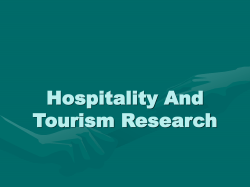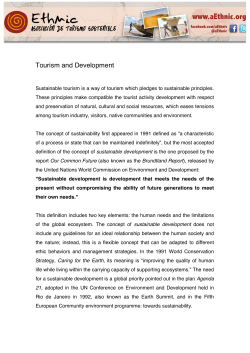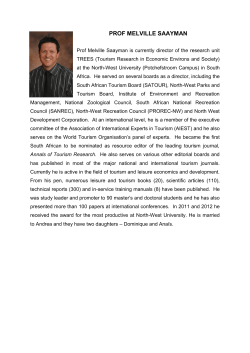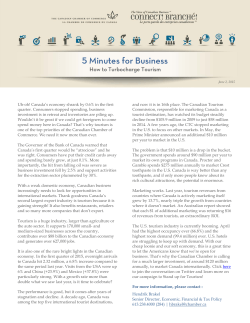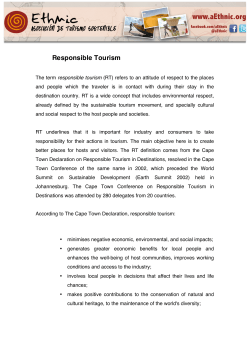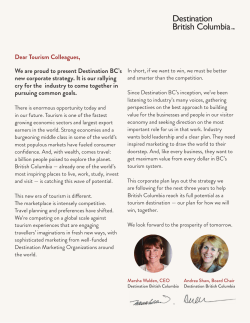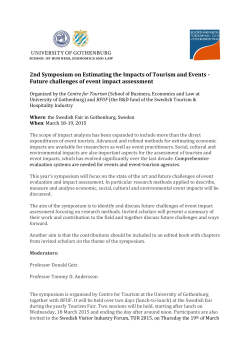
OPEN DOOR
Feature TOURISM IN JAPAN OPEN DOOR Creating a convenient, fun and tour-friendly country TAMI KAWASAKI J APAN has enjoyed a dramatic influx of overseas visitors in recent years. That includes not just people headed for major destinations like Tokyo and Kyoto, but also travelers intent on enjoying the scenery at regional destinations and events and theme parks full of local flavor. The shape of tourism in Japan—and the locations it is taking people to—is becoming ever more diversified. With Tokyo chosen as the venue for the 2020 Tokyo Olympics and Paralympics, even greater numbers of tourists are expected to be touring Japan. We sat down with Shigeto Kubo, commissioner of the Japan Tourism Agency, to hear about how the government is working to make their travel experience even better. What trends do you see in the number of visitors to Japan? There were 8.36 million visitors to Japan in 2012. We cleared our target figure of 10 million in 2013, and exceeded 13 million in 2014. With an increase of five million in just two years, this has been a dramatic leap forward. Currently we are aiming to welcome twenty million visitors for the 2020 Tokyo Olympics and Paralympics, and pushing closer to our goal by promoting Japan as a tourism nation. an Interview with Shigeto Kubo COMMISSIONER of the Japan Tourism Agency 6 | highlighting japan What specific efforts are being made to open Japan up to travelers? We plan to continue relaxing travel visa requirements, such as offering a one-step waiver on visas for Indonesian nationals. We’re also planning to cut the maximum wait time for immigration checks at all airports—including regional ones—to twenty minutes. To make our system as easy and convenient as possible for visitors to enter Japan, we are expanding the budget and number of personnel for customs, immigration and quarantine. We’re also posting multilingual signage at museums, parks, tourist destinations, roadways and public transit facilities to help travelers enjoy their time here without struggling with the language. We’ve held symposiums to explore this issue with specialists, experts in the tourism industry and foreign students studying in Japan, and have also created a set of guidelines for multilingual services. For instance, we are standardizing and improving the wording used from the point of view of actual visitors; for example, hot springs resorts should not be called “spas,” but rather onsen, which is gradually becoming a familiar term globally. Promoting these guidelines will let us expand their use across the country, fostering a more multilingual environment. We are also expanding the availability of ATMs that accept overseas cards and free Wi-Fi facilities—two services that visitors have frequently requested. In addition, we’re increasing the number of michinoeki (roadside rest stops that offer regional food and entertainment) and convenience stores that serve as information hubs. We want to create a climate where tourists can get the information they need and feel comfortable touring without additional assistance. In addition, we are offering information for Muslim travelers. We seek to promote understanding so that tourism in Japan can be better enjoyed, through creating guidebooks listing restaurants that offer religiously appropriate meals, places of worship and receptive accommodations. We are also advising Japanese restaurants and hotel operators on aspects such as properly labeling food ingredients. What projects are you promoting that make tourism in Japan even more attractive? In October 2014, we extended the tax exemption from nonconsumable products to all products. This means comestibles like food and alcohol, consumables like pharmaceuticals and cosmetics, and local specialty goods and other items are all tax-exempt, so travelers can enjoy purchasing a wide range of Japanese goods. We’re also setting up tax-free counters in shopping malls or at enclosed shopping centers so that shoppers can handle the tax-free process for everything they buy in a shopping mall or enclosed shopping center in one place, instead of having to fill out paperwork at each store, as well as simplifying the tax-free documents themselves. We want shopping in Japan to be a stress-free, enjoyable experience. In terms of diversifying the travel experience and what tourism means, we want to take Japanese traditional cuisine—which has been gaining ground since obtaining Intangible Cultural Heritage status—and traditional Japanese inns—the emblem of traditional Japanese hospitality—and make them flagship items that define Japan’s “brand” by promoting the delicious local food and elegant inns available throughout the country. We want people to feel enthusiastic about touring more places around the country, including the areas surrounding where they stay, and learning about Japan’s many faces, so we’re creating various tour routes and promoting them as ideal ways to see a bit of everything. We also want travelers to see that Japan has things to offer year-round, such as superb shopping, safe and comfortable transit options and a robust support structure that makes travel easy. We invite everyone to come to Japan and experience our spirit of hospitality firsthand. Numbers of Foreign Tourists Visiting Japan by Country / Region—2014 Changes in the Number of International Visitors to Japan 13.414 million 10,000 visitors visitors (29.4% increase) 1300 Reached 1341 10 million 1200 visitors 1100 900 800 700 861 835 836 Japan 733 Campaign 679 673 Philippines 180,000 (1.4%) 622 614 521 Indonesia 160,000 (1.2%) 400 300 Malaysia 250,000 (1.9%) 200 Singapore 230,000 (1.7%) 100 0 2003 United States 890,000 (6.6%) Vietnam 120,000 (0.9%) Visit 600 500 835 Launched Other 820,000 (6.1%) France 180,000 (1.3%) England 220,000 (1.6%) Canada 180,000 (1.4%) India 90,000 (0.7%) 1036 1000 Australia 300,000 (2.3%) Russia 60,000 (0.5%) Germany 140,000 (1%) 2004 2005 2006 2007 2008 2009 2010 Source: Japan National Tourism Organization (JNTO) 2011 2012 2013 Thailand 660,000 (4.9%) Taiwan 2.83 MILLION (21.1%) Europe 540,000 (4.0%) North America 1.07 million (8%) TOTAL 13.41 Million Asia: 10.61 Million (79.1%) East Asia: 8.92 Million (66.5%) Southeast Asia: 1.6 Million (11.9%) Korea 2.76 MILLION (20.5%) Hong Kong 930,000 (6.9%) China 2.41 million (18%) 2014 april 2015 | 7
© Copyright 2025
